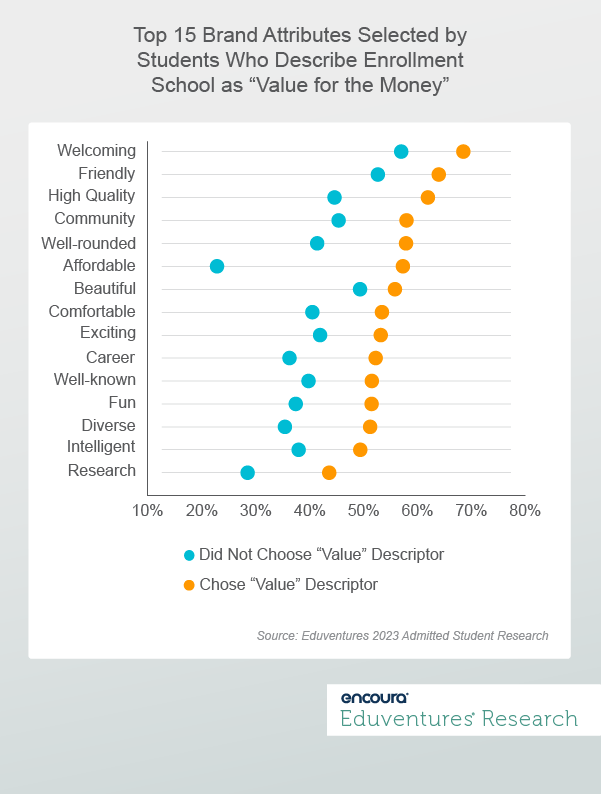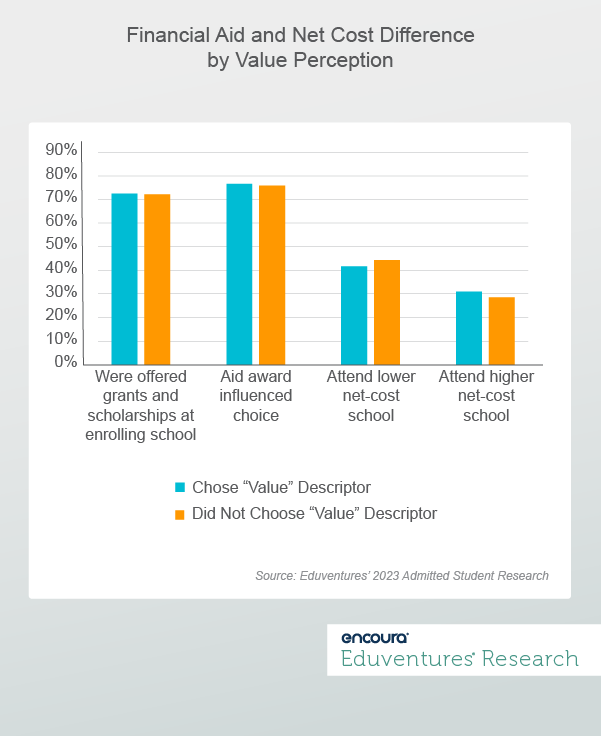According to a New America study, 63% of GenZ think a high school diploma or technical certificate is sufficient for personal financial security. Consequently, there has been a decline in the percentage of American high school graduates immediately entering college. Despite college emphasis on value in their recruitment messages, fewer young Americans see the merit in pursuing higher education.
Are we reaching a tipping point where the cost of higher education exceeds perceived benefits, or are colleges miscommunicating value? And what does the data say about how those who still enroll in college perceive value?
Value Means Affordable
Eduventures’ Admitted Student Research™ asks college-bound high school seniors to select words that best describe their chosen institution. The most common choices are “welcoming” (48%), “friendly” (45%), “beautiful” (41%), “community” (39%), and “high quality” (39%).
But a welcoming and friendly community isn't typically the highest priority for enrollment. Students reported their top three enrollment drivers as “academic strength” (61%), “affordability” (52%), and “career preparation” (37%)—the essential components of the value equation. Surprisingly, only 26% of the fall 2023 class used the term "value-for-the-money" to describe their chosen school.
What led these students to believe that their selected schools offered good value compared to those who didn't use this descriptor? Figure 1 presents the brand attributes most frequently chosen by students who described their schools as "value-for-the-money" and compares them to the choices made by students who did not use the value descriptor.

Overall, students who selected the attribute “value-for-the-money” to describe their enrollment institutions have stronger associations, show greater enthusiasm, and select more attributes for their choices compared to those who did not use a value descriptor.
Having more associations with a school indicates greater affinity, which is why enrolling students tend to select more attributes than non-enrolling students. Figure 1 suggests that students who see their chosen schools as a good value also seem to be more excited about their choices.
Despite the stronger associations among enrolling students who see value in their schools, Figure 1 highlights several notable gaps:
- “Value” students are far more likely to describe their choices as affordable (a 34% gap) underscoring the significant weight of affordability in the value equation.
- Other gaps that are greater than the average difference (12% gap) include “high quality” (17%), “intelligent” (16%), “career” (16%), and “well-rounded” (16%).
- While not in the top 15 associations, “value” students are also more inclined to describe their schools as “practical” (a 21% gap), indicating that the core value equation revolves around perceived academic quality and practical career prospects for the cost of attendance. Many institutions address these factors when promoting value.
Additionally, institutional type also plays a role in how students perceive value. “Value” students at public institutions place great importance on career, while those at private in-state colleges prioritize quality. “Diverse” is associated with in-state publics, “research” with out-of-state publics, “fun” and “exciting” with in-state privates. This highlights secondary attributes associated with value, often varying by institutional type and, at a more granular level, by institutional brand.
Affordability is in the Eye of the Beholder
Despite affordability being the most significant factor in the value proposition, it's not necessarily the case that students perceive their choices as valuable if they offer substantial grant aid and a low net cost (Figure 2).

Figure 2 shows that the 26% of students who describe their enrollment schools as “value-for-the-money” were just as likely to have received grants and scholarships than students who did not use the value descriptor, and these awards did not significantly influence them more. In fact, those who perceive their choices as a good value are somewhat more likely to say that the net cost of their choices is higher than the net cost they would have paid at their closest alternative choices.
Given that affordability is closely linked to value, how do we reconcile this apparent cognitive dissonance?
The answer may lie in the demographics of students who choose to describe their enrollment schools as a good value. These students are less likely to live in low-income households, less likely to be first-generation students, and are more likely to be White than the students who do not associate their choices with value. In other words, the student demographics who experienced the most significant enrollment declines over the past few years do not perceive the value of college—even among those who enrolled this fall. The missing link in this analysis is the students who decided that college is not worth the cost—a growing population.
The value perception of higher education, it seems, is most strongly associated with privilege.
The Bottom Line
The old value equation—a combination of cost, quality, and career outcomes—still holds, at least for those who are still college-bound. But it is not evenly distributed.
Students from historically marginalized backgrounds are less likely to see the value of a college education. High cost and concerns about fitting into academic environments can lead to uncertainty about the choice: something that recruitment messaging alone will not be able to ease.
Rather, institutions should reflect on whether they are fulfilling their promises.
- Do students from all backgrounds have the same chances to complete their degrees?
- Do graduates get jobs and careers in their chosen fields?
- Are students able to repay student loans?
- Can your institution demonstrate, not just promise, value?
- How are you altering your value proposition for different segments of students with different Mindsets about college?
The value equation seems simple enough, but is difficult to articulate convincingly unless you can demonstrate its veracity and consider the lens through which students see their own educational journeys.
Never Miss Your Wake-Up Call
Learn more about our team of expert research analysts here.
Eduventures Senior Analyst at Encoura
Contact
This recruitment cycle challenged the creativity of enrollment teams as they were forced to recreate the entire enrollment experience online. The challenge for this spring will be getting proximate to admitted students by replicating new-found practices to increase yield through the summer’s extended enrollment cycle.
By participating in the Eduventures Admitted Student Research, your office will gain actionable insights on:
- Nationwide benchmarks for yield outcomes
- Changes in the decision-making behaviors of incoming freshmen that impact recruiting
- Gaps between how your institution was perceived and your actual institution identity
- Regional and national competitive shifts in the wake of the post-COVID-19 environment
- Competitiveness of your updated financial aid model
Never Miss Your Wake-Up Call
Learn more about our team of expert research analysts here.

